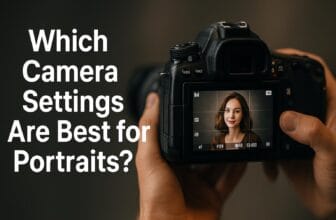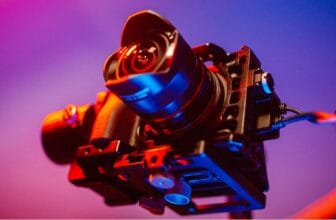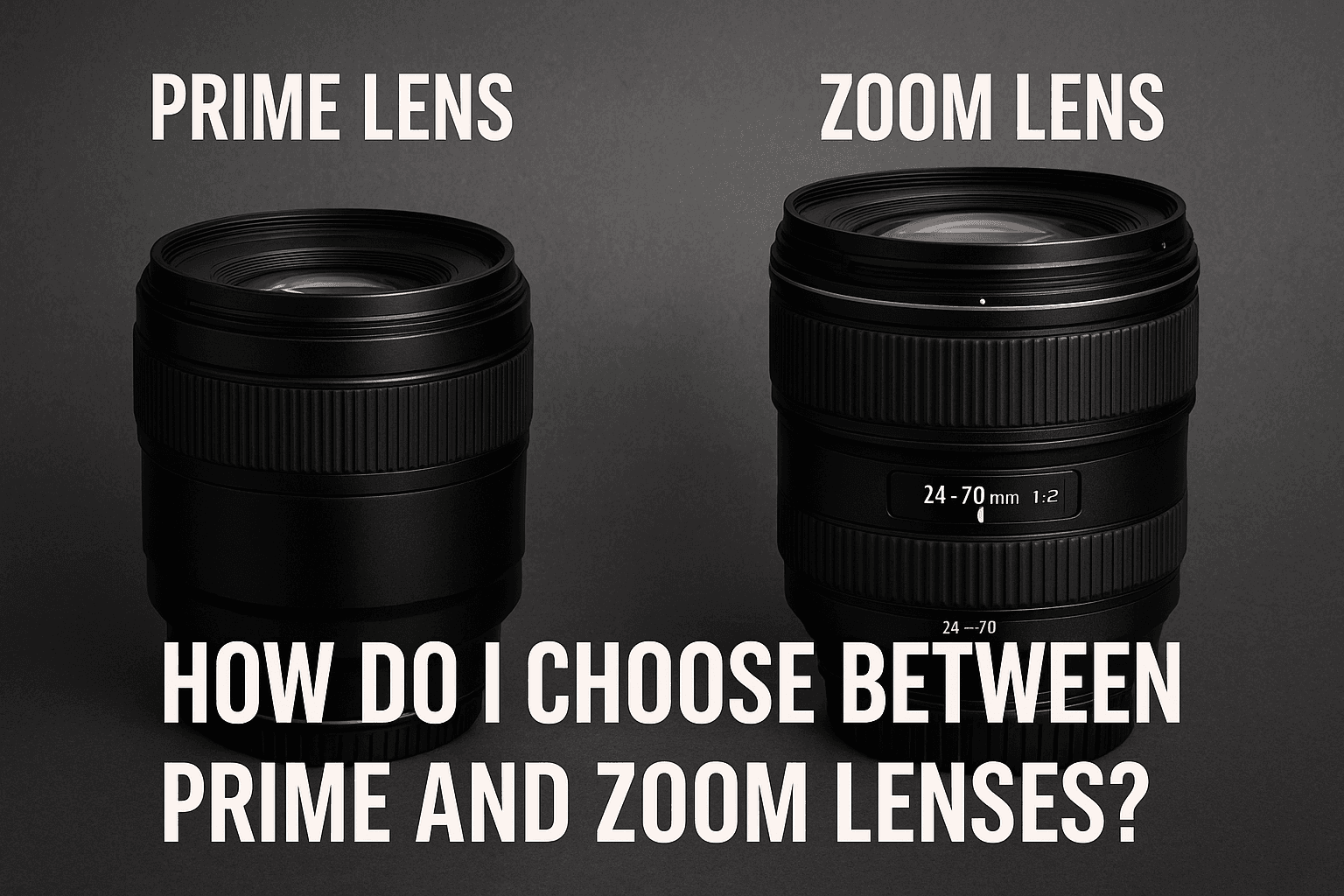
How Do I Choose Between Prime and Zoom Lenses? The Ultimate Guide for Photographers & Videographers
When you’re ready to upgrade your camera gear, the lens you choose can make or break your creative journey. One of the first questions new (and even experienced) photographers and videographers face is: How do I choose between a prime lens and a zoom lens? Is image quality your top priority, or do you need maximum flexibility? Should you invest in several lenses, or carry just one for all situations? Let’s dive deep into the world of camera lenses, so you can confidently make the right choice for your style, needs, and budget.
Table of Contents
Prime vs. Zoom Lenses: The Basics
Key Differences Between Prime and Zoom Lenses
Advantages of Prime Lenses
Disadvantages of Prime Lenses
Advantages of Zoom Lenses
Disadvantages of Zoom Lenses
How to Choose: Key Factors to Consider
Real-World Scenarios: Which Lens is Best?
Prime vs. Zoom for Video, Travel, and Beginners
Prime Lens vs. Zoom Lens: Photo Comparisons
Prime and Zoom Lenses for Popular Camera Brands
Final Thoughts: Which Lens Should You Choose?
Prime vs. Zoom Lenses: The Basics
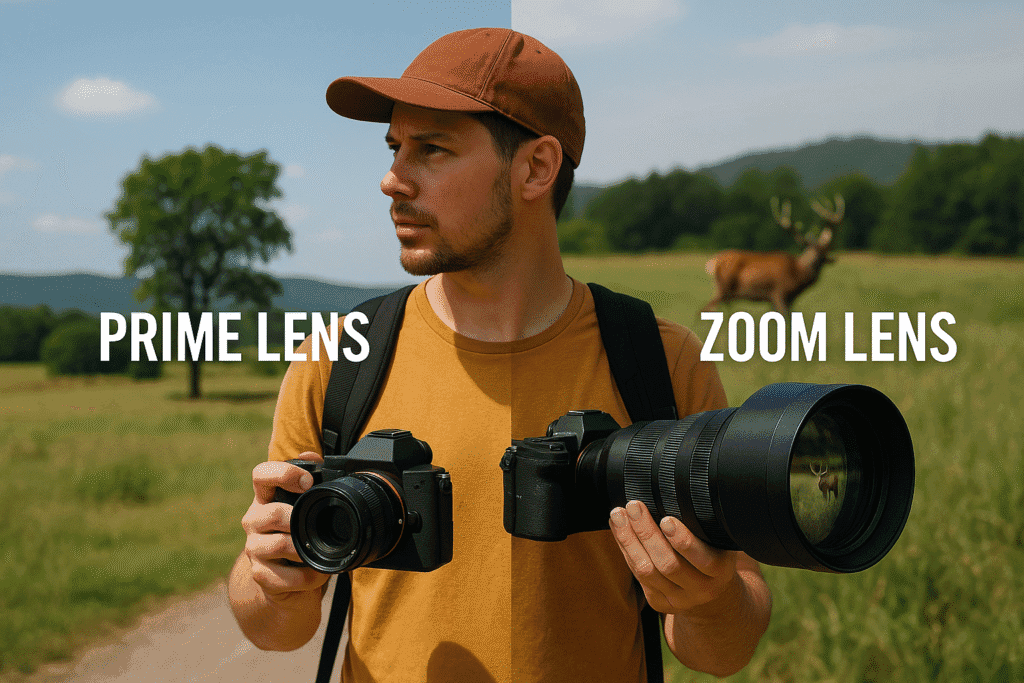
Before you make your choice, it’s important to understand what sets prime lenses and zoom lenses apart.
Prime lenses have a fixed focal length (like 35mm, 50mm, or 85mm). You can’t zoom in or out—you “zoom with your feet,” moving closer or farther from your subject.
Zoom lenses offer a range of focal lengths (like 24-70mm or 70-200mm), allowing you to adjust your composition without changing your position or swapping lenses.
Each lens type has its own strengths, weaknesses, and ideal use cases. The decision is not always obvious—let’s break it down further.
Key Differences Between Prime and Zoom Lenses
Focal Length Flexibility:
Prime: Fixed focal length; you get one field of view.
Zoom: Variable focal length; you can capture wide, medium, and tight shots with one lens.
Image Quality:
Prime: Known for exceptional sharpness, contrast, and low-light performance due to simpler optical design.
Zoom: Quality has improved dramatically, but top primes usually edge out zooms in sharpness and clarity.
Aperture:
Prime: Often have wider maximum apertures (f/1.2, f/1.4, f/1.8), which means better performance in low light and more dramatic background blur (bokeh).
Zoom: Maximum apertures are typically smaller (f/2.8, f/4, or variable), but some high-end zooms offer constant apertures across their range.
Portability:
Prime: Compact and lightweight.
Zoom: Can be bulky, especially those with long ranges or fast apertures.
Versatility:
Prime: More specialized, ideal for specific shots or styles.
Zoom: Extremely versatile—one lens can replace several primes in your bag.
Advantages of Prime Lenses
1. Superior Image Quality
Prime lenses usually deliver sharper, more vibrant images with less distortion and fewer optical flaws. They often outperform zooms at the same focal length.
2. Wider Apertures for Low Light and Bokeh
A big draw of primes is their wide maximum apertures, like f/1.4 or f/1.8. This means:
Better low-light performance (faster shutter speeds, lower ISO)
Creamy, beautiful background blur (bokeh) for portraits, food, or detail shots
3. Lightweight and Discreet
Prime lenses tend to be smaller and lighter than zooms, making them perfect for street photography, travel, or shooting all day without fatigue.
4. Encourages Creative Composition
Because you can’t zoom, primes force you to move and think about your shot, improving your composition skills over time.
5. Affordability
Most entry-level primes cost less than professional zooms, especially for fast apertures.
Example:
The Canon RF 50mm f/1.8 STM is a classic affordable prime, known for its sharpness and versatility.
Disadvantages of Prime Lenses
Limited Flexibility: You can’t change your field of view without physically moving or swapping lenses.
May Require Multiple Lenses: To cover a range of perspectives (wide, standard, telephoto), you’ll need to carry several primes.
Missed Shots: In fast-moving environments, you might miss a shot because you have the wrong focal length attached.
Advantages of Zoom Lenses
1. Maximum Versatility
Zoom lenses let you cover wide to telephoto perspectives in seconds—perfect for dynamic, unpredictable scenes like weddings, wildlife, or events.
2. Fewer Lens Changes
With a zoom, you’re less likely to miss the action while swapping lenses.
3. Travel-Friendly (Sometimes)
One high-quality zoom can replace a bag full of primes, making travel lighter (despite the zoom’s larger size).
4. Cost-Effective Coverage
Instead of buying three or four primes, one zoom lens can give you the equivalent range, often for less money.
Example:
The Sony FE 24-70mm f/2.8 GM II is a popular “walk-around” zoom lens favored by professionals for its flexibility and sharpness.
Disadvantages of Zoom Lenses
Potentially Lower Image Quality: Although modern zooms are excellent, primes generally win at any given focal length for sharpness and bokeh.
Heavier and Larger: Especially fast-aperture (f/2.8) and long-range zooms.
Smaller Maximum Aperture: Most zooms max out at f/2.8 or f/4, which affects low-light shooting and background blur.
Price: High-end zooms with constant wide apertures can be expensive.
How to Choose: Key Factors to Consider
1. Your Photography Style and Needs
Portraits, Food, and Product Photography: Prime lenses excel due to their wide apertures and image quality.
Events, Travel, Sports, or Wildlife: Zoom lenses offer the versatility you need for quickly changing scenes.
2. Budget
Entry-level primes are typically more affordable than professional zooms.
A quality zoom lens might save money compared to buying several primes.
3. Portability
Will you carry multiple lenses or just one? For run-and-gun shooting, a zoom is hard to beat.
If you value lightweight gear, choose compact primes.
4. Creative Control
Do you want razor-thin depth of field and dramatic background blur? Go prime.
Need to quickly reframe without moving? Go zoom.
5. Low-Light Shooting
Primes (with f/1.4 or f/1.8) are superior for low-light situations, like indoor events or night street photography.
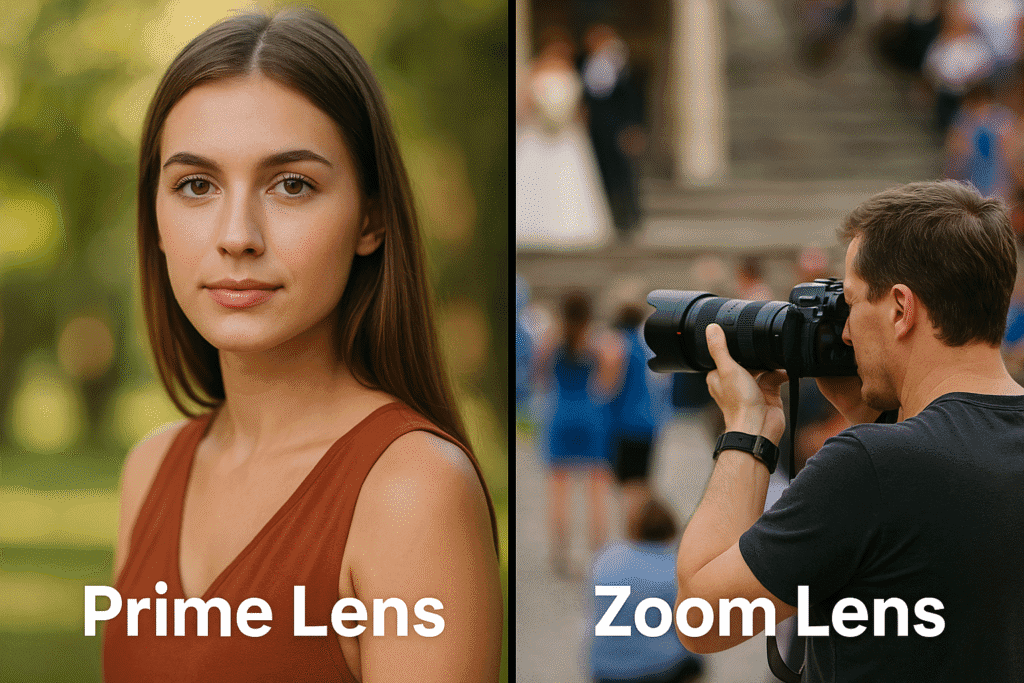
Real-World Scenarios: Which Lens is Best?
Let’s apply this knowledge to typical scenarios:
Travel Photography
Zoom Lens Advantage: When traveling light and fast, a lens like the Canon RF 24-105mm f/4L IS USM covers wide vistas, street scenes, and portraits without swapping glass.
Prime Lens Advantage: If you want beautiful, atmospheric travel portraits or night scenes, pack a 35mm or 50mm prime for bokeh and low-light.
Street and Documentary Photography
Prime Lens: A fast 35mm or 50mm prime is a street photographer’s classic, giving you a natural perspective and making you blend in.
Wedding and Event Photography
Zoom Lens: A 24-70mm f/2.8 or 70-200mm f/2.8 lets you capture wide group shots and intimate moments from afar—all with one lens.
Filmmaking
Prime Lenses: Many filmmakers favor prime lenses for their cinematic look, better low-light performance, and beautiful bokeh.
Zoom Lenses: Useful for documentaries or run-and-gun shooting when you need to change focal lengths quickly.
Prime vs. Zoom for Video, Travel, and Beginners
Prime lens vs zoom lens for video:
Primes: Offer cinematic image quality and wider apertures for shallow depth of field. Best for controlled environments.
Zooms: Essential for dynamic shoots, interviews, or documentary work where you need to quickly adjust your framing.
Prime vs zoom lens for travel:
Zooms: More convenient for covering all scenarios without switching lenses.
Primes: Superior for low-light or creative travel shots, but you may need to pack more than one.
Prime or zoom lens for beginners:
Beginners often start with a kit zoom for versatility. As your style develops, try a 50mm prime to see the benefits of sharpness, bokeh, and low-light performance.
Prime Lens vs. Zoom Lens: Photo Comparisons
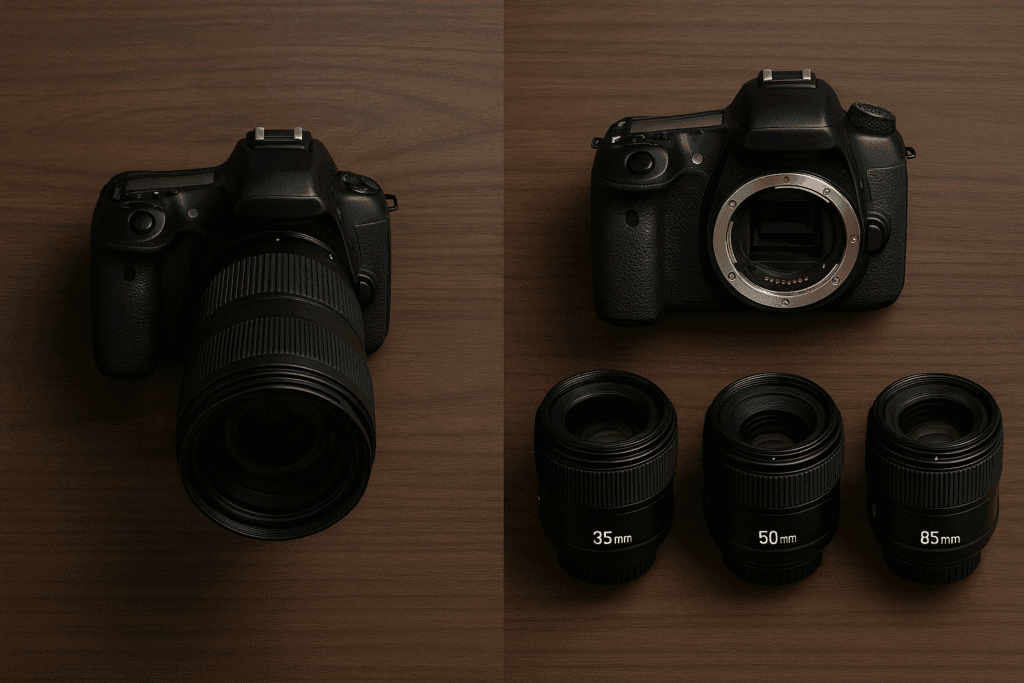
Seeing is believing! If you want to compare the difference in look, search for prime lens vs zoom lens photo comparison on YouTube or photography blogs. You’ll notice:
Primes: Sharper focus on the subject, creamier background blur, and better low-light clarity.
Zooms: More flexibility for composition, especially useful for candid or fast-paced shooting.
Prime and Zoom Lenses for Popular Camera Brands
Sony
Best Prime: Sony FE 50mm f/1.8
Best Zoom: Sony FE 24-70mm f/2.8 GM II
Canon
Best Prime: Canon RF 50mm f/1.2L USM
Best Zoom: Canon RF 24-105mm f/4L IS USM
Nikon
Best Prime: Nikon Z 50mm f/1.8 S
Best Zoom: Nikon Z 24-70mm f/2.8 S
These lenses are all highly rated and loved by photographers worldwide. Check for compatibility with your camera before purchasing.
FAQs: Choosing Between Prime and Zoom Lenses
What are the disadvantages of zoom lenses?
Bulkier, heavier, and sometimes less sharp than primes
Usually have smaller apertures (f/2.8 or f/4)
Can be expensive for top-tier models
Why would a filmmaker choose to use a prime lens instead of a zoom lens?
For superior image quality, wider apertures, and the classic “cinematic” look with shallow depth of field
Why would a zoom lens be a better choice than a prime lens for a photographer who is traveling with a heavy load?
Zooms reduce the need for multiple lenses, making travel gear lighter and more convenient
In what situations would a zoom lens be preferred over a prime lens?
Weddings, sports, wildlife, travel, and any fast-paced, unpredictable environment where you need flexibility
Final Thoughts: Which Lens Should You Choose?
Choosing between a prime lens and a zoom lens is a personal decision, but here’s a quick summary to help you decide:
Go Prime if:
You crave ultimate image quality, love creative shallow depth of field, shoot in low light, and don’t mind carrying multiple lenses or “zooming with your feet.”Go Zoom if:
You need to cover a variety of subjects quickly, want maximum flexibility, travel light, or shoot fast-paced events and don’t want to change lenses often.
Still undecided? If possible, rent or borrow both types and try them out on a weekend shoot. Nothing beats hands-on experience.
Ready to Elevate Your Photography?
Whether you’re a beginner or a seasoned pro, the lens you choose will shape your creative vision. Got questions, favorite lenses, or sample photos you want to share? And if you found this guide helpful, be sure to share it with your fellow photographers and subscribe for more in-depth photography tips.
Happy shooting—and may you always have the right lens for the moment!

I am a USMC Veteran who worked with a Lot of computers and Technology while I was in. I became hooked and learned a lot in my 20 years.
At my store, I am passionate about bringing you the latest tech products that enhance your everyday life. Our mission is to provide quality, innovation, and value, making sure you find the perfect gadgets to fit your needs. Thanks for Your Support.. Larry Mac

